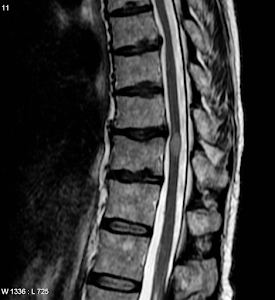Trapped Within: Exploring Locked-In Syndrome and the Mysteries of Neuroanatomy
Locked-In Syndrome
A person with locked-in syndrome experiences quadriplegia and bulbar palsy due to damage to the brainstem though cognition and vertical eye movements are preserved in many patients.
The condition's survivors frequently suffer from crippling motor loss, although early diagnosis, supportive care, and rehabilitation have been found to improve people's quality of life.
Locked-in syndrome is caused by damage to a specific part of your brainstem known as the pons.
Patient Presentation
Quadriplegia, bulbar palsy, and lack of sensation throughout the body as a result of injury to the brain stem, most often the anterior pons. Patients with the syndrome typically retain their classically maintained cognition, hearing, blinking, and vertical eye movement.
Types of locked-in syndrome:
- Classic form: Complete immobility, but one can move their eyes vertically, blink and maintain your usual cognitive abilities.
- Incomplete form: In this type of locked in syndrome the presentation is similar to the classic form but there is some sensation and movement intact.
- Total immobility form: In this type the patient looses all of their movement including the eye movement which was preserved in the classic form but still has his/her cognitive abilities intact. So doctors diagnose this with and electroencephalogram by monitoring brain activity in real time.
"Is anybody in there?!!"
Symptoms:
Depends on the type of Locked in syndrome the patient has, most people with locked in syndrome are missed diagnosed initially to be in a coma.
- Hear
- Think and reason
- Blink
- Move eyes up and down but not side to side.
- Chew
- Swallow
- Speak
- Perform any body movements below their eyes
- Make facial expressions
Neuroanatomy:
Locked-in syndrome is caused by damage to a specific part of your brainstem called the pons.
The medulla oblongata, the base of your brainstem, and the cerebellum—a region of your brain that is essential to almost all physical movement, including coordination—are joined by the pons, a wide mass of nerve fibers curved like a horseshoe.
So incase of vascular insult of the pons the connection between the spinal cord, muscles, and medulla with the structures above the pons that is the mid brain and the cerebrum is lost.
Loss of corticospinal tracts leads to quadriplegia unlike cerebrum strokes which cause hemiplegia as fibers from the entire cerebrum are condensed in this tiny space within the pons. So even a small stroke will cause a massive loss of function.
As we know that the facial nerve nucleus lies at the level of the pons, so when it is affected in locked in syndrome the patient is unable to move the facial muscles leading to loss of the ability to show facial expression.
The lateral rectus muscle of the eye which moves it laterally gets its motor supply from the 6th cranial nerve i.e. Abducens nerve, which has its nucleus in the pons. Therefore in locked in syndrome there is loss of ability to moves eyes horizontally. The other extra-ocular muscles are supplied by the oculomotor nerve and the trochlear nerve which are not located in the pons rather above it so they remain unaffected in locked in syndrome.
The muscles of the eye lid are also supplied by the 3rd cranial nerve so patient retains the ability to blink.
Most patients cannot speak, chew and swallow as the vagus, glossopharyngeal and hypoglossal nerves supplying the muscles of larynx, pharynx and tongue are affected as their nucleus is placed below the pons in the medulla.
The patient has normal cognitive ability, is able to see, hear and process the information but cannot show any body movement so it is like one is locked inside their body hence the name "LOCKED IN SYNDROME"
MRI scans showing pontine infarcts
Management
There is no cure or specific treatments for locked-in syndrome other than treating the cause and preventing further complications, if possible.
Management of locked-in syndrome includes supportive therapy and communication training.
Supportive therapy:
- Ventilator support
- Tracheostomy
- Ryle's tube insertion
- Foley's catheter insertion
- Prevention of pressure sores
- Providing physical therapy to prevent limb contractures
Communication therapy:
Speech therapists can help people with locked-in syndrome (LiS) communicate more clearly with eye movements and blinking.
Do READ and amazing case report in JAMA Neurology.
SG
Resources
- https://www.ncbi.nlm.nih.gov/books/NBK559026/
- https://www.bmj.com/content/330/7488/406.full
- https://my.clevelandclinic.org/health/diseases/22462-locked-in-syndrome-lis
- https://jamanetwork.com/journals/jamaneurology/fullarticle/2383121
- https://radiopaedia.org/articles/locked-in-syndrome-3








Comments
Post a Comment